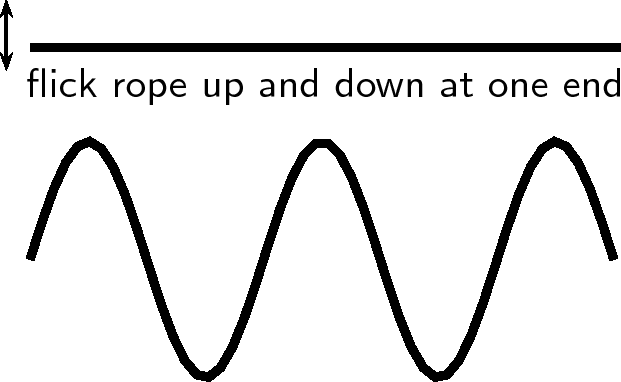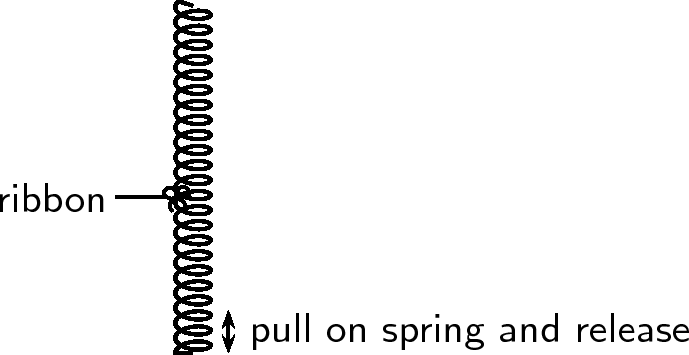| << Chapter < Page | Chapter >> Page > |
We have already studied transverse pulses and waves. In this chapter we look at another type of wave called longitudinal waves. In transverse waves, the motion of the particles in the medium were perpendicular to the direction of the wave. In longitudinal waves, the particles in the medium move parallel (in the same direction as) to the motion of the wave. Examples of transverse waves are water waves or light waves. An example of a longitudinal wave is a sound wave.
When we studied transverse waves we looked at two different motions: the motion of the particles of the medium and the motion of the wave itself. We will do the same for longitudinal waves.
The question is how do we construct such a wave?
To create a transverse wave, we flick the end of for example a rope up and down. The particles move up and down and return to their equilibrium position. The wave moves from left to right and will be displaced.

A longitudinal wave is seen best in a spring that is hung from a ceiling. Do the following investigation to find out more about longitudinal waves.

From the investigation you will have noticed that the disturbance moves parallel to the direction in which the spring was pulled. The spring was pulled down and the wave moved up and down. The ribbon in the investigation represents one particle in the medium. The particles in the medium move in the same direction as the wave. The ribbon moves from rest upwards, then back to its original position, then down and then back to its original position.

As in the case of transverse waves the following properties can be defined for longitudinal waves: wavelength, amplitude, period, frequency and wave speed. However instead of peaks and troughs, longitudinal waves have compressions and rarefactions .
As seen in [link] , there are regions where the medium is compressed and other regions where the medium is spread out in a longitudinal wave.
The region where the medium is compressed is known as a compression and the region where the medium is spread out is known as a rarefaction .

The wavelength in a longitudinal wave refers to the distance between two consecutive compressions or between two consecutive rarefactions.

The amplitude is the distance from the equilibrium position of the medium to a compression or a rarefaction.
The period of a longitudinal wave is the time taken by the wave to move one wavelength. As for transverse waves, the symbol is used to represent period and period is measured in seconds (s).
The frequency of a wave is the number of wavelengths per second. Using this definition and the fact that the period is the time taken for 1 wavelength, we can define:
or alternately,
The speed of a longitudinal wave is defined as:
where
The musical note “A” is a sound wave. The note has a frequency of 440 Hz and a wavelength of 0,784 m. Calculate the speed of the musical note.
We need to calculate the speed of the musical note “A”.
We are given the frequency and wavelength of the note. We can therefore use:
The musical note “A” travels at .
A longitudinal wave travels into a medium in which its speed increases. How does this affect its... (write only increases, decreases, stays the same ).
We need to determine how the period and wavelength of a longitudinal wave change when its speed increases.
We need to find the link between period, wavelength and wave speed.
We know that the frequency of a longitudinal wave is dependent on the frequency of the vibrations that lead to the creation of the longitudinal wave. Therefore, the frequency is always unchanged, irrespective of any changes in speed. Since the period is the inverse of the frequency, the period remains the same.
The frequency remains unchanged. According to the wave equation
if remains the same and increases, then , the wavelength, must also increase.

Notification Switch
Would you like to follow the 'Siyavula textbooks: grade 10 physical science [caps]' conversation and receive update notifications?